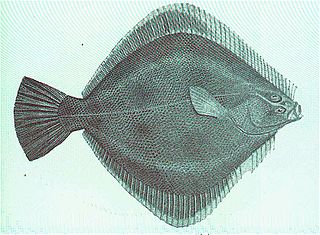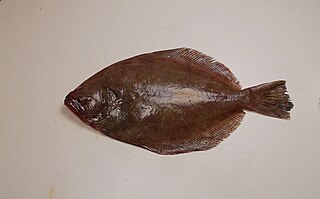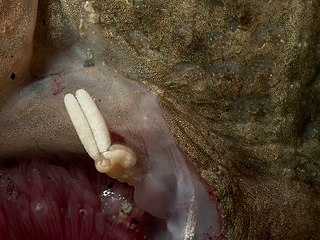
Flounders are a group of flatfish species. They are demersal fish, found at the bottom of oceans around the world; some species will also enter estuaries.

A flatfish is a member of the ray-finned demersal fish order Pleuronectiformes, also called the Heterosomata, sometimes classified as a suborder of Perciformes. In many species, both eyes lie on one side of the head, one or the other migrating through or around the head during development. Some species face their left sides upward, some face their right sides upward, and others face either side upward.

Pleuronectidae, also known as righteye flounders, are a family of flounders. They are called "righteye flounders" because most species lie on the sea bottom on their left sides, with both eyes on their right sides. The Paralichthyidae are the opposite, with their eyes on the left side. A small number of species in Pleuronectidae can also have their eyes on the left side, notably the members of the genus Platichthys.

The California halibut or California flounder is a large-tooth flounder native to the waters of the Pacific Coast of North America from the Quillayute River in Washington to Magdalena Bay in Baja California. It feeds near shore and is free swimming. It typically weighs 6 to 30 pounds. It is much smaller than the larger and more northern-ranging Pacific halibut that can reach 300 pounds (140 kg).

The black flounder, also known by the Māori language name mohoao, is a flatfish of the genus Rhombosolea, found around New Zealand in shallow enclosed waters and coastal freshwater lakes. Its adult length ranges from 20 to 45 cm.

The starry flounder, also known as the grindstone, emery wheel and long-nosed flounder, is a common flatfish found around the margins of the North Pacific.

The New Zealand sand flounder is a righteye flounder of the genus Rhombosolea, found around New Zealand in shallow waters down to depths of 100 m.
Gastropsetta frontalis, the shrimp flounder, is a species of large-tooth flounder, the only member of its genus Gastropsetta. It is endemic to the western Atlantic Ocean, from North Carolina to Florida, and from the northern Gulf of Mexico to Panama. It also occurs in The Bahamas.

The yellowtail flounder, also known as the rusty dab, is a species of flatfish in the family Pleuronectidae. Reaching 56 cm (22 in) in length, it has reddish brown upperparts, pale underparts and yellow fins. Both its eyes are on the right (upper) side of its body. Found in the western North Atlantic, it has been fished commercially by North American fisheries for food. A victim of overfishing, the yellowtail flounder is categorized as "Vulnerable" by the International Union for Conservation of Nature.

The European flounder is a flatfish of European coastal waters from the White Sea in the north to the Mediterranean and the Black Sea in the south. It has been introduced into the United States and Canada accidentally through transport in ballast water. It is caught and used for human consumption.

The summer flounder or fluke is a marine flatfish that is found in the Atlantic Ocean off the East Coast of the United States and Canada. It is especially abundant in waters from North Carolina to Massachusetts.

Paralichthys lethostigma, the southern flounder, is a species of large-tooth flounder native to the East Coast of the United States and the northern Gulf of Mexico. It is a popular sport fish and is the largest and most commercially valuable flounder in the western North Atlantic Ocean and Gulf of Mexico. It is a "left-eyed flounder", meaning the left side is pigmented and is the "up side".

Platichthys is a genus of flatfish native to the North Pacific and North Atlantic oceans. Despite being in the family Pleuronectidae, all four species in the genus Platichthys are often "lefteyed", i.e. they lie on the sea bottom on their right side, with both eyes on the left side.

The Pacific sand sole, also known as simply sand sole, is a flatfish species inhabiting the northeastern Pacific waters where it lives on sandy bottoms. The only species in the genus, Psettichthys, it ranges from the Bering Sea to Northern California.
The peppered flounder is a flatfish of the family Paralichthodidae and the only species of the genus Paralichthodes. It is a demersal fish that lives on sandy and muddy bottoms in subtropical waters, at depths of up to 100 metres (330 ft). Its native habitat is the southeastern Atlantic and the western Indian Ocean, specifically the African coastline from Mossel Bay, South Africa, to Delagoa Bay, Mozambique. It grows up to 50 centimetres (20 in) in length.

The peacock flounder, also known as the flowery flounder, is a species of fish in the family Bothidae. The species is found widely in relatively shallow waters in the Indo-Pacific, also ranging into warmer parts of the East Pacific.

The willowy flounder is a flatfish of the family Pleuronectidae. It is a demersal fish that lives on bottoms at depths of between 100 and 200 metres. Its native habitat is the temperate waters of the Western Pacific, from Southern Hokkaido in Japan to the Gulf of Bohai, the East China Sea and Taiwan. It can grow up to 30 centimetres (12 in) in length. It is sometimes classified in the monotypic genus Tanakius.

The Arctic flounder, also known as the Christmas flounder, eelback flounder and Polar plaice, is a flatfish of the family Pleuronectidae. It is a demersal fish that lives on coastal mud bottoms in salt, brackish and fresh waters at depths of up to 90 metres (300 ft). Its native habitat is the polar waters of the northeastern Atlantic and Arctic oceans, from the White and Barents seas to the coasts of Siberia in Russia and Queen Maud Gulf in Canada, and from the Chuckchi and Bering seas to Bristol Bay in Alaska and the northern Sea of Okhotsk. It can grow up to 35 centimetres (14 in) in length.
Citharichthys abbotti, the Veracruz whiff, is a species of flatfish in the large-tooth flounder family Paralichthyidae. It is endemic to the southwestern Gulf of Mexico, found on the Eastern Mexico Continental Shelf, with Veracruz to the south and the Rio Grande to the north.

Acanthochondria cornuta is a species of parasitic copepod from the northeast Atlantic Ocean, and the type species of the genus Acanthochondria. It infects the gills of several species of flatfish, particularly the European flounder. Copepodids and immature females infect the holobranch of the host, while adult females prefer the pseudobranch and the internal wall, suggesting they migrate upstream in the gills of the host as they mature.

















